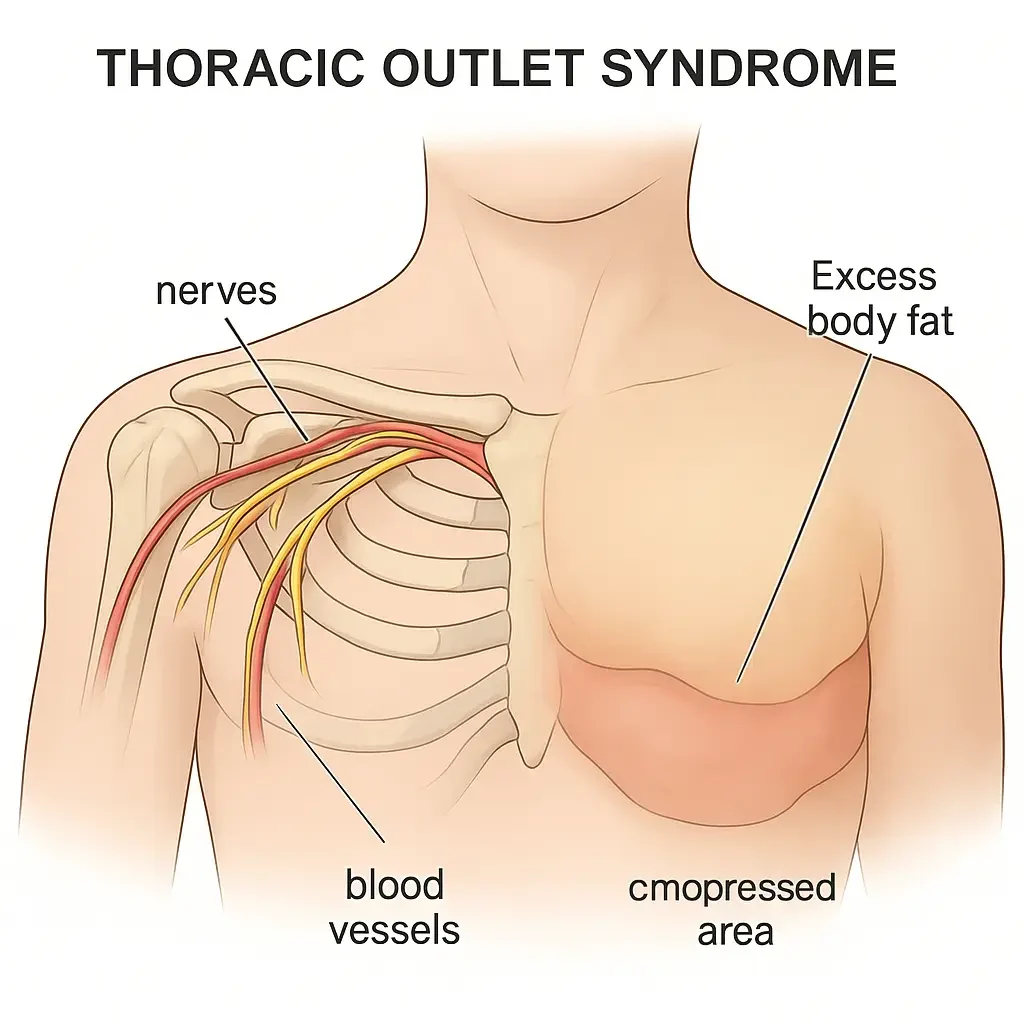Thoracic Outlet Syndrome
How Weight Gain Can Lead to Thoracic Outlet Syndrome?
A significant and often overlooked element among thoracic outlet syndrome causes is weight gain. This condition results from the compression of nerves or blood vessels in the thoracic outlet, a narrow passageway located between the collarbone and the first rib. Although causes are frequently linked to trauma or repetitive stress, increased body mass is a substantial risk factor that can instigate and worsen the disorder. Excess weight can alter posture, reduce the space in the outlet, and contribute to the compression. Recognizing that weight is a modifiable component of TOS is vital, as it empowers individuals to pursue informed lifestyle changes and seek effective medical management strategies.

Understanding Thoracic Outlet Syndrome
It encompasses a group of disorders caused by compression, injury, or irritation of the axone as well as nerves and blood vessels in the thoracic outlet area. This narrow passageway between your collarbone and first rib houses vital structures, including the brachial plexus nerves and subclavian blood vessels. When these structures become compressed, patients experience symptoms ranging from numbness and tingling to severe pain and weakness.
The condition manifests in three primary types: neurogenic (affecting nerves), venous (affecting veins), and arterial (affecting arteries). Neurogenic thoracic outlet syndrome accounts for approximately 95% of all cases, making it the most common form encountered by thoracic outlet syndrome experts in Los Angeles.
How does Weight Gain contribute?
Postural Changes and Muscle Imbalances
Excess weight significantly alters body mechanics and posture, creating conditions that are favorable for the development of this disease. Additional weight around the midsection pulls the shoulders forward, causing a rounded shoulder posture that narrows the thoracic outlet space. This postural deviation increases pressure on nerves and blood vessels, initiating the compression cycle characteristic.
Inflammation and Tissue Changes
Weight gain promotes systemic inflammation throughout the body, including the thoracic outlet region. Inflammatory processes cause tissue swelling and fluid retention, further reducing the already limited space within the thoracic outlet. This inflammatory cascade compounds existing compression issues and creates new pressure points.
Reduced Physical Activity
Individuals who experience weight gain often decrease their physical activity levels, which can lead to muscle weakness and poor physical conditioning. Weak shoulder and neck muscles cannot adequately support proper posture, allowing gravitational forces to compress thoracic outlet structures. This creates a self-perpetuating cycle where symptoms worsen due to continued inactivity.
How to Fix This Through Weight Management?
Comprehensive Weight Loss Strategies
Effective treatment often begins with addressing underlying weight issues. Gradual, sustainable weight loss reduces pressure on thoracic outlet structures while improving overall posture and muscle function. A combination of dietary changeovers, regular exercise, and lifestyle changes forms the foundation of successful weight management.
Targeted Exercise Programs
Specific exercises can address both weight concerns and symptoms of TOS simultaneously. Strengthening workouts for the upper back, shoulders, and core muscles help restore proper posture, while cardiovascular activities promote weight loss and overall health. Physical therapy programs designed by experts can provide personalized exercise protocols tailored to each individual’s needs.
How to Treat TOS?
Medical Interventions
Professional treatment ranges from conservative management to surgical intervention, depending on the severity of the condition. Initial treatments typically include:
- Physical therapy and postural correction
- Anti-inflammatory medications
- Nerve blocks and injections
- Ergonomic modifications
- Weight management programs
Advanced Treatment Options
For cases unresponsive to conservative treatment, advanced interventions may be necessary. These include thoracic outlet decompression surgery, rib resection, or vascular reconstruction procedures performed by specialists.
What to Do If You Have TOS?
Immediate Steps
If you suspect, seek evaluation from qualified healthcare providers experienced in diagnosing this complex condition. Early intervention can prevent symptom progression and improve treatment outcomes. Document your symptoms, including their frequency and triggers.
Long-term Management
Successful management requires a sustained commitment to lifestyle modifications, including maintaining an ideal weight, engaging in regular physical activity, and developing postural awareness. Working with experts in Los Angeles ensures access to the latest treatment protocols and specialized care.
Prevention Strategies
Preventing TOS through weight management involves maintaining a healthy BMI, engaging in regular physical activity, and practicing good posture habits. Early intervention for weight gain can prevent the development and related complications.
Weight gain significantly contributes to the causes of this disease through multiple mechanisms, including postural changes, inflammation, and muscle weakness. Understanding this connection empowers patients to take proactive steps in prevention and treatment. Professional evaluation and comprehensive treatment plans address both weight management and symptoms of this disease for optimal outcomes.
Don’t let TOS control your life. The expert team at Encino Vascular Institute specializes in comprehensive diagnosis and treatment, including weight-related management. Our board-certified specialists combine advanced medical expertise with personalized care to help you achieve relief. Contact Encino Vascular Institute today to schedule your consultation and take the first step toward reclaiming your health and mobility.
FAQs
Can losing weight cure thoracic outlet syndrome?
While weight loss can significantly improve symptoms and reduce compression, a complete cure depends on the underlying cause and severity. Many patients experience substantial symptom relief through weight management combined with other treatments.
How much weight gain increases the risk of thoracic outlet syndrome?
Even modest weight gain of 10-15 pounds can alter posture enough to contribute to TOS development. The risk increases progressively with each additional pound of weight gain.
Are there specific exercises for overweight patients with thoracic outlet syndrome?
Yes, low-impact exercises focusing on posture correction and gentle strengthening are recommended initially. As weight decreases and symptoms improve, exercise intensity can gradually increase.
How long does it take to see improvement with weight loss?
Many patients notice symptom improvement within 4-6 weeks of consistent weight loss efforts, though individual results vary based on starting weight and other factors.
Should I see a specialist for thoracic outlet syndrome treatment?
Yes, thoracic outlet syndrome requires specialized knowledge for proper diagnosis and treatment. Vascular specialists and thoracic surgeons have expertise in managing this complex condition.